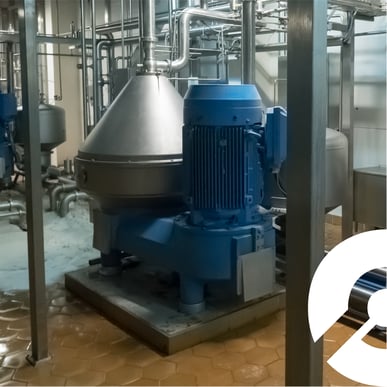Minimizing your centrifuge’s electricity and water usage can save your plant a lot of money. A well-maintained centrifuge can last a lifetime, meaning that optimizing your centrifuge’s operations can result in big savings in the long run.
Oftentimes, we see centrifuge efficiency impacted by:
- Air entrapment in the raw milk going into the centrifuge (signaled by a lot of foam in the skim or cream discharge)
- Temperature-related issues
- Flow-rate issues
- Leaky valves or pluggage
Let’s explore a few ways that you can save on costs by changing how you operate your centrifuge.
Slowly bring your bowl up to speed
Modern centrifuge equipment runs on variable frequency drives (VFDs), which bring a bowl up to speed over time using frequency. This differs from older centrifuge motors that run across the line and use a significant amount of energy to bring bowls up to speed quickly.
VFDs bring bowls up to speed slowly, cutting energy use by nearly half. For example, a motor started across the line will pull about 600% in-rush current. In comparison, a VFD will limit its in-rush current to a maximum of 150%. With this limit in place, your equipment can preserve energy — and ultimately reduce your energy bill costs, as well.
While VFDs are a standard for new equipment today, many plants are still utilizing centrifuges that have been around for decades and draw excess energy to operate. While upgrading to a VFD will require an initial investment, it quickly becomes an easy way to cut operating costs.
Convert your clutch to VFD
We still see a few plants using clutches when we conduct service visits. The cost of a fluid clutch versus replacing it with a direct drive coupling will pay for itself after two cycles. Because of this, we don’t even remanufacture centrifuges with a fluid clutch anymore.
At Separators, we can convert your equipment to a VFD drive, offering you a more streamlined operation and significant energy cost savings.
Reduce speed for cleaning in place
When running cleaning in place (CIP), you don’t need all of the G-force that your centrifuge normally creates. If you reduce your speed for your CIP wash cycle by around 10%, you can save energy and still sufficiently clean your equipment. When CIP is complete, bring your equipment back to full speed for production. While it’s a small trick, it can save you a lot in energy costs over the lifecycle of your centrifuge.
Be careful not to overfeed your centrifuge
We regularly visit dairy plants that have outgrown their equipment and are overfeeding their centrifuge. As a result, they don’t get the efficiency ratings they’d like when producing skim milk and cream. The easiest solution for this problem is to feed less into the centrifuge.
Of course, we know that most plants can’t afford to slow down their production rate; therefore, a plant facing this issue will need to buy a bigger centrifuge, or buy an additional centrifuge, to continue making a quality product while meeting their desired production volume.
Replace outdated centrifuge models
Older centrifuge models (such as the 318 and the 418) were created when water consumption wasn’t a big concern. As a result, these models use high flow, high volume to operate their bowls, which uses a significant amount of water compared with the equipment available on the market today.
For example, instead of using a 0.5-inch line to open and close the bowl, newer models now use Operating Water Module Compact (OWMC) modules, which have more precise measurement technology — and in turn, use less water.
Update your automation technology
Dairy plants produce a high volume of products each day — and as a result, are prone to operational challenges. Automation control systems create communication between your equipment and the people running the show. This means you can better identify product abnormalities or contamination, and can easily track dairy temperatures to create consistent, quality, safe products.
Regardless of what brand and model you have at your plant, our team provides on-site automation service, training, troubleshooting, and support. By updating and customizing your centrifuge’s automation technology, you can better optimize your plant’s operations and ensure that there is no unnecessary energy or water use in your production process.
Talk with a centrifuge expert
Regular maintenance with Separators can help your plant stay ahead of these types of issues. When our technicians are at your plant, they will examine your centrifuge and identify problems associated with overfeeding your equipment. This can help give your centrifuge a longer life and help you anticipate when you might need to invest in your equipment to keep up with your growing production volumes.
Curious if your operations could be optimized?

